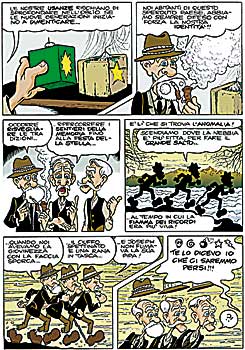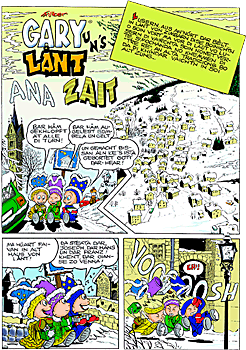
Eldorado Press Cartoon is proud to present Gary and the Village Suspended in Time. Produced in 2004 by Fulber Creazioni of Trento and the Luserna Istituto Culturale Cimbro (Lusern Cimbri Heritage Institute), it is the first editorial cartoon project on the Cimbri people of Lusern in Trentino.
This easy-going adventure once again sees the cartoon characters Gary and Spike, created by Fulber thirty years ago, projected back in time to pick up on the cry for help from a people who have been fighting for their existence for centuries.
The story unwinds in the Cimbri town of Lusern situated in south-east Trentino and tells of the mission of Joseph, Hans and Franz, three lively, white-haired villagers who through the mists of time attempt to save the memory of their traditions from the winds of oblivion.
Along the way they find Gary and Spike and together they make the “Big Leap”, a kind of space-time jump to Lusern in 1910, just after the fire that destroyed part of the town and on the threshold of the outbreak of the First World War.
It is a journey into a mountain people’s customs and humble crafts that are performed to the beat of the passing seasons. The journey is made through the eyes of disenchanted youth, which the three old Cimbri, magically transformed back into children, make our likeable protagonists relive in order to protect their great treasure: their ancient and unique language.
The origins of a language that remained locked in the 14th Century
According to a careful study, the Cimbrian language has been classified as the oldest peripheral Germanic spoken language in existence. It is attributable to the people who came from Bavaria and the eastern Tyrol and migrated into Italy in the decades following the year one thousand.
Only in the 13th century, however, did these people colonize south-east Trentino, founding the village of Lusern. The Cimbrian language only continues on in this little town where it is spoken by almost all the people thanks to centuries of isolation and the pride of the whole community.
It is both unique and rare that the Cimbrian language has been preserved intact until today without being corrupted by forms such as slambrot (once spoken in the nearby communities).
It is the first time that a cartoon deals with this interesting ethnic island and its cultural roots.
Within a few months of publication Gary and the Village Suspended in Time has been reprinted in colour in Italian, German and Cimbrian.
 
WHO ARE THE CIMBRI?
The Cimbri are a Germanic people originating in the south of Bavaria who occupied a vast area between the Adige and Brenta Rivers between 1050 and 1200. The oldest document relating to the migration of the Cimbri is certainly that of Benediktbeuern. It lists the names of the heads of the families (with their respective villages of origin) who migrated towards Verona during a time of famine (1053-1063).
All the event’s characters come back to life, as if in a film, in the ideal and meaningful setting “Heritage Centre” (Haus von Pruuk).
|
